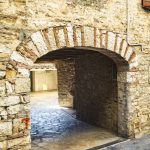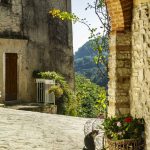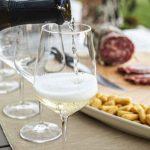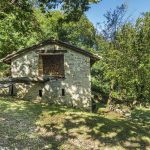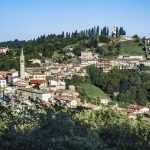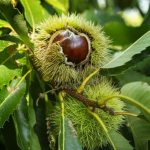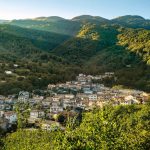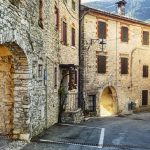Wine and chestnuts: a perfect match
Discovering the village of Combai, home of PGI Chestnuts and the local Verdiso wine

By Paolo Colombo
Photo Joe Murador
Anyone who doesn’t believe in the perfect marriage really should visit Combai. This is because the charming village of just 480 souls, nestled in the narrow valley at the foot of Monte Cesen, halfway between the hamlets of Miane and Guia near Valdobbiadene, is home to one of the happiest food and wine ‘marriages’ to be found in the Conegliano Valdobbiadene hills: the perfect pairing of chestnuts, in particular the extra-large variety known locally as marroni, and wine, in this case produced from the native Verdiso grape.
Referred to as Combayo in ancient documents, the name Combai seems have its origins in the Latin culmen vallis, meaning ‘the head of the valley’ – a reference to its elevated position amid the beautiful hills of the Valsana area. Evidence suggests the first settlement here was a farm, placed in a strategic position to control the valley, and presented to a Roman mercenary named Metellus as a reward for his military endeavours somewhere between 350 and 400 AD – a fact also referenced by local historian Michele Pagos in one of his books on the subject. One of the first written mentions of Combayo dates back to 1027 in a deed transferring ownership from the then emperor of the Holy Roman Empire Conrad II the Salic, to the Bishop-Count of Feltre and Belluno. Subsequently in the Middle Ages, Combai came under the control of the parish of Miane before control was passed to the Brandolini counts.
Just outside the town, you can still walk along the Strada de la Fan (the Hunger Road), a narrow, cobbled path that climbs the woods above the hill to reach the area of Costalada. The road is a relic that recalls the tragic events of the Great War. Originally created by the Austrians to provide access for their cannons which they used to bombard the Piave plain, it took its name from the fact that the village’s elderly, women and children were employed to build it. In return, they would receive some thin soup and a hunk of bread, which they accepted as the alternative was starvation. Today, some sections of the original cobblestones can still be seen.
COMBAI CHESTNUTS
The road is part of the Sentiero dei Marroni (The Chestnut Trail), which wends its way through what is without doubt Combai’s most prized area: its chestnut groves. Lucio Colmellere is an expert in traditional mountain culture and today he cultivates chestnuts and owns around thirty chestnut trees which he inherited from his father. We met up with him in the locality of Casere Pardolin, at 520 metres above sea level: “The cultivation of chestnut trees has ancient origins,” he told us. “The Romans would always plant them in new settlements as the wood is extremely durable and ideal for constructing defensive palisades. Perhaps it was Metellus himself who first planted them here. What is certain is that the cultivation of chestnut trees for food purposes existed here as early as the 17th century.”
Lucio is a member-producer of the Combai Association of Chestnut Producers, which numbers some 200 chestnut growers from across the Treviso Prealps Community. Combai’s Marrone chestnuts, which have enjoyed PGI status since 2009, are considered one of the area’s most prized varieties. “Growing chestnut trees requires great effort and much passion,” continues Lucio. “the work includes clearing away the undergrowth and pruning. Chestnuts are also extremely delicate and perishable, so they have to be handled and tended with great care.”
In the kitchen, chestnuts can be used in many ways, as appetisers, in desserts, jams and beermaking, as well as soups and flours. “But the best way to enjoy them is simply roasted over an open fire, in the traditional way” says Vittoria Moro, president of the Combai Tourist Office, which organises the town’s annual Chestnut Festival. Now in its 79th edition, the event will take place from 6 to 29 October, just after the grape harvest. “In addition to sampling our chestnuts, visitors can enjoy food stands with traditional specialities which all feature chestnuts as one of their ingredients, while walks and special exhibitions will be held in the surrounding area. This year one is dedicated to vintage postcards.” (The complete program is available on the Tourist Office website at www.combai.it)
VERDISO
It would be remiss to talk about chestnuts without mentioning Verdiso, another of Combai’s most prized products – and one which pairs perfectly with the chestnuts. Verdiso is an indigenous vine and along with Bianchetta and Perera grapes it’s used as a blending variety for Prosecco Superiore. Its traditional ties with the area have prompted some courageous and visionary winemakers to produce it as a single-grape variety in its own right. One if these is Luca Pederiva, owner of a historic winery in Combai who believes whole-heartedly in Verdiso as a niche product, though one which is enjoying an ever-increasing following of enthusiasts: “This is the most suitable area for its cultivation because of the stony soil. It’s a fresh-tasting wine, with a fine acidic note which pairs perfectly with light dishes such as fish, shellfish and risottos made with wild greens, and obviously also with chestnuts. In addition to the still version, we also make a brut sparkling version.” In order to demonstrate that the marriage between chestnuts and Verdiso is set to endure, there’s also the Verdiso Wine Road, the Friends of Verdiso Association, and an exhibition showcasing this wine called “È Verdiso”. The event, which will take place in Combai in May, is part of the series of exhibitions that make up the Prosecco Superiore Spring.
[Article originally published in Visit Conegliano Valdobbiadene magazine Fall Winter 2023. The entire magazine is available here]
